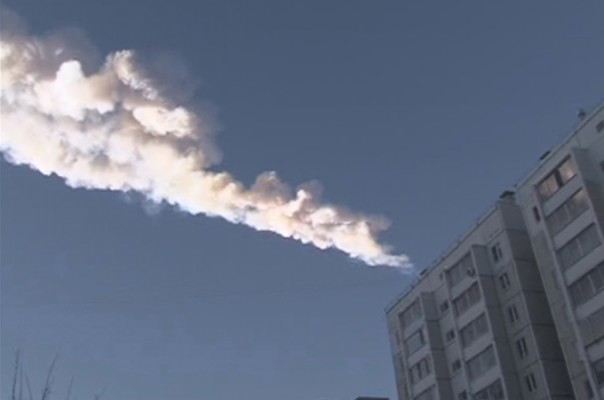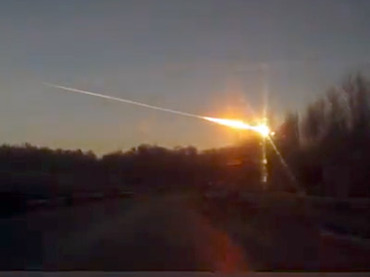
A meteor streaked the sky above Russia’s Ural Mountains today Friday, February the 15th, causing several sonic booms and reportedly injuring over 1000 people, of which many got hurt by broken glass from shattered windows. The meteorite fragments fell in the Tjeliabinsk region in the Ural Mountains.

Meteorite Hits Russia
With many buildings damaged in over six cities according to the Russian Interior Ministry. A zinc factory has reportedly collapsed according to Interior Ministry spokesman Vadim Kolsenikov.
An eyewitness in Chelyabinsk tells Reuters that a loud bang was followed by a shock wave that caused buildings to sway in the city center. And an amateur video distributed by the Reuters news agency shows a streak in the distant sky, apparently from the meteor.
Asteroid Passing Earth
This terrifying event does however not correlate with the asteroid “2012 DA14” that will pass by the Earth later this Friday. This is a relatively large rock about the size of an apartment building and will pass by the Earth at a distance of about 27,680 kilometers (17,200 miles).
The video below by NASA regarding the near-Earth asteroid 2012 DA14. NASA’s Near-Earth Object Program Office accurately predicts the asteroid’s path, and it is therefore known and analyzed with no chance of the asteroid colliding with Earth.
Nevertheless, the flyby will provide a unique opportunity for researchers to study a near-Earth object up close. Just 30 years ago we would not have been able to detect the asteroid.
The definition of a NEO (near earth object) is an object that comes within 50 million kilometers (31 million miles) of the Earth’s orbit. Astronomers believe that there are hundreds of thousands of NEOs, with about 95 percent of the largest NEOs mapped.
Updated:
Asteroid 2012 DA14 passes Earth
The small near-Earth asteroid 2012 DA14 passed safely by Earth on Feb. 15, 2013. Its closest approach, about 17,150 miles above the Indian Ocean.











![OpenAI. (2025). ChatGPT [Large language model]. https://chatgpt.com](https://www.illustratedcuriosity.com/files/media/55136/b1b0b614-5b72-486c-901d-ff244549d67a-350x260.webp)
![OpenAI. (2025). ChatGPT [Large language model]. https://chatgpt.com](https://www.illustratedcuriosity.com/files/media/55124/79bc18fa-f616-4951-856f-cc724ad5d497-350x260.webp)
![OpenAI. (2025). ChatGPT [Large language model]. https://chatgpt.com](https://www.illustratedcuriosity.com/files/media/55099/2638a982-b4de-4913-8a1c-1479df352bf3-350x260.webp)








